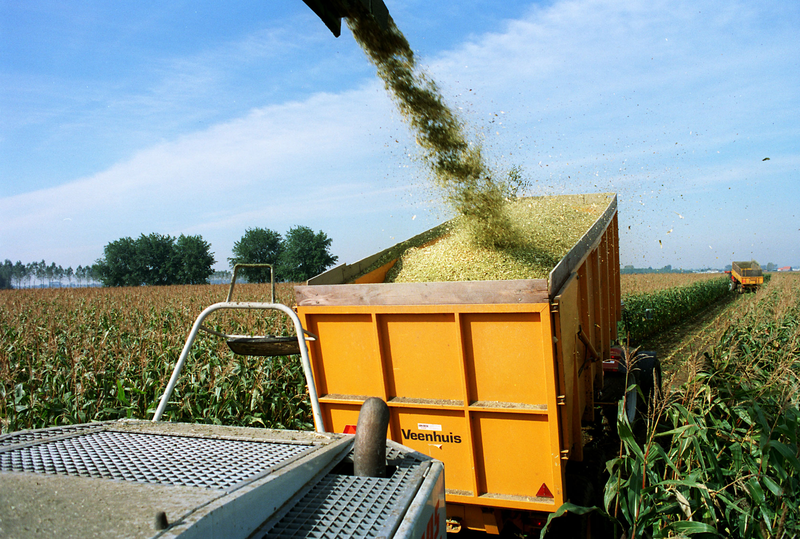
The main reasons for efficient fermentation are:
- To preserve nutrients
- To optimize the intake and performance of your cows
- During the fermentation process to minimize forage dry matter losses
- To minimize spoilage at feed-out
Good management practices in the making of silage are to the utmost importance to prevent or minimize losses in forage dry matter. The losses of the dry matter often goes undetected, good silage management practices involves the following:
- Harvesting the crop at proper moisture and stage of maturity
- Filling of the storage structure as quickly as possible
- Firm compacting of the ensiled material, and also
- Proper sealing with plastic to minimize exposure to oxygen.
What happens during the fermentation process, will be the result of your quality and quantity of silage being fed to your cows.
The fermentation process involves aerobic bacteria (oxygen exposure) and anaerobic bacteria (non-oxygen exposure) where both play a very important role. It also contains Lactic acid bacteria (LAB) and acetic acid bacteria (AAB), which will be explained to you in the following stages.
There are six stages involved in the fermentation process of silage.
Stage 1
Stage 1 starts at harvesting time when you harvest at ideal conditions of moisture, the chop length, and firm packing of the forage. After you harvest, aerobic organisms are present on the forage surface. This stage is undesirable because of the aerobic bacteria that is present because it consumes soluble carbohydrates that might otherwise be available for the beneficial lactic acid bacteria. This stage continues until the oxygen supply or water-soluble carbohydrates are depleted. The desired anaerobic conditions are being created as the oxygen is being reduced. The respiration process produces water and heat, and excessive heat build-up, that reduces the digestibility of nutrients which you want to prevent.
Additionally, during this stage, the breakdown of the plant protein also occurs. This can be reduced by a faster rate of pH drop which will minimize protein breakdown. The pH at this stage is between 6 – 6.5, so the acid environment stops the activity of the enzymes that are responsible for the breaking down of protein. It is very important to get rid of oxygen as soon as possible by compacting the forage properly as quickly as possible. This stage ends once the oxygen is being eliminated.
Stage 2
Stage 2 starts when the oxygen is depleted in the silage. Once the oxygen is depleted anaerobic hetero-fermentation occurs, and both acetic and lactic acid are produced, and the primary bacteria in this stage is called Enterobacteria. The fermentation of soluble carbohydrates and the production of acetic acid starts to happen. Acetic acid is desirable because it initiates the pH drop in the forage, as the pH goes below 5 the acetic bacteria starts to decline and the bacteria growth is being inhibited, and so lactic acid starts to being produced. When this occurs it is the beginning of Stage 3.
Stage 3
Stage 3 generally lasts only 1 day, the homo-fermentative bacteria rapidly starts to drop the pH of the fermenting forage by producing lactic acid as an end product. The bacteria in this stage are inhibited as the temperature of the silage decrease and the pH continues to drop.
Stage 4
This stage is a continuation of Stage 3, as the temperature stabilizes, the homo-fermentative bacteria convert soluble carbohydrates to lactic acid, which helps preserve silage as the pH is dropping effectively, as the lactic acid bacteria begin to increase. Efficient preservation should consist of 60% or more of the total silage organic acid produced. Stage 4 is the longest in the fermentation process from 4 days up to 21 days, it continues until the pH of the forage is low enough to prevent the growth of all bacteria. The forage is in a preserved state when the pH of 4 is reached. As long as oxygen is kept from the silage no further negative processes will occur. Up until the end of Stage 4, it normally takes 21 days from harvest. It is recommended that you only can start feeding silage after 3 weeks.
The fermentation process can vary in time depending on the type of crop harvested, moisture, and maturity of the ensiled crop. High-quality inoculants that are applied properly can decrease the fermentation period.
Stage 5
This stage remains during storage of the preserved forage, where the fermentation process is stable and no oxygen is penetrating the silage, for example through silo walls and torn plastic covers.
The final pH of the ensiled forage depends on the type of forage and the condition at the time of ensiling. The final pH of haylage is around 4,5 and corn silage around 4.
Stage 6
Stage 6 is important in the ensiling process as it refers to the stage where oxygen is reintroduced to the silage because of silage being fed out. Oxygen is reintroduced to the silage and can result in dry matter losses because of secondary aerobic decomposition. To minimize dry matter losses proper management of the silage face, and at the feed, bunk is very important.
Important to remember.
The fermentation process of forage starts at harvesting, and that can determine your quality and quantity of your end product.
We as de Heus understand what matters to our customers by being involved in their business every day. By utilizing our SynchroFOS system we understand the importance of good quality roughage on the farm. In South Africa is Maize Silage one of the main roughage sources available. To support this, the Opti Maize concept was developed. To estimate the desired harvest time of Maize crops for silage maize, this unique tool was developed.
An easy three-step system can be done on the farm by one of our highly trained Technical Advisors, we can roughly determine the right dry matter percentage of the plant and the whole crop, and according to that estimate the correct time of harvest.
The benefit of this is to cut at the right time which is one of the most important factors, and by that to improve the quality of your maize silage. Larger yield per hectare is also achieved and reducing input costs, and by that, it increases your margins.
For more information regarding the correct time of harvest of silage, speak to your nearest De Heus technical advisor today.


